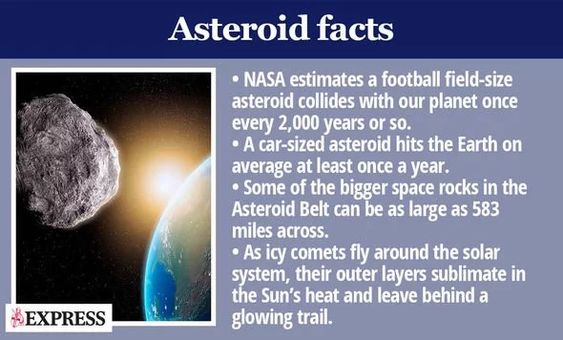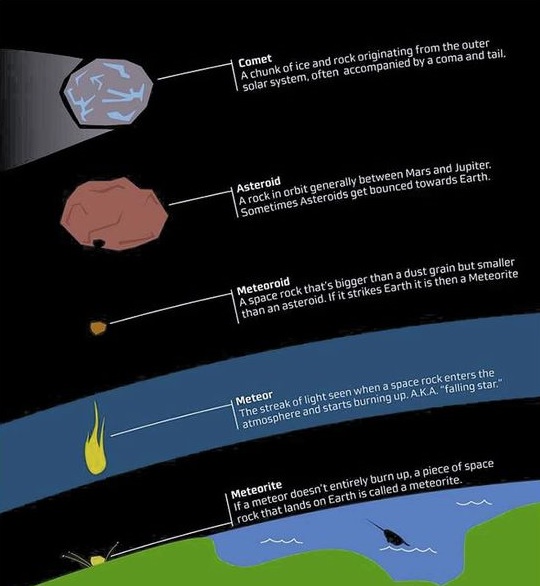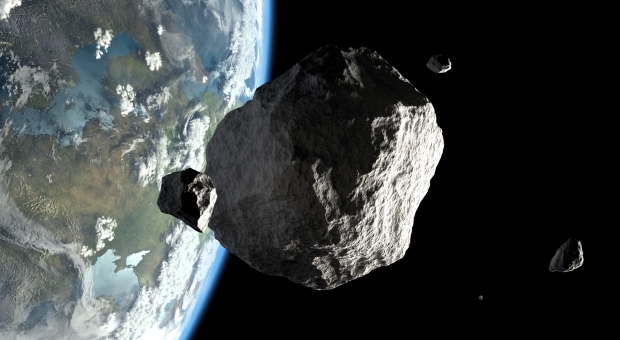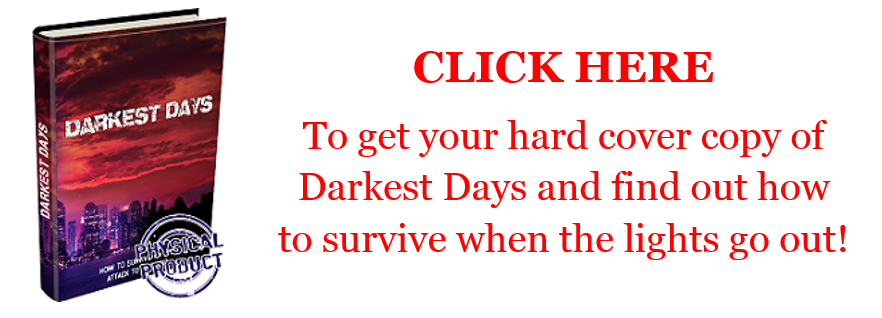Some of the earliest survival novels I remember reading were about surviving the collision of an asteroid striking the Earth.
That was a popular theme 40 or 50 years ago, back when the space race was in full swing and we were sending people to the moon. The concern was very real, with a number of books written about it and movies dealing with the theme. But they all boiled down to one of two options; destroy the asteroid or abandon the Earth.
Neither of those options is actually very realistic. As great as our technology is, we don’t have the ability to destroy even a small asteroid, either by landing on it and blowing it up or by shooting it with a nuclear missile. And if we were to try and evacuate the Earth, where would any of us go? Would another planet just conveniently show up to take Earth’s place (that happened in one fictional piece).
Click here to find out how to survive when the lights go out!
Yet the interest in this sort of scenario is increasing in recent months. NASA has been working on improving their ability to track asteroids and comets, seeking to be better prepared to protect the Earth. I’m still not sure what we’d do if an apocalyptic sized comet was seen heading our way; but at least we’d know it is coming.
The reality is, if a comet or asteroid ever does impact the Earth, we’re going to have to ride it out, hoping it isn’t too bad. In this case, “too bad” is a relative term, as any major asteroid impact could end up being pretty bad indeed.
We’re Being Bombarded
Few people realize it, but we’re being bombarded by space junk every day. Each and every day, approximately 100 million tons of dust and sand sized particles enter the atmosphere, drawn in by Earth’s gravity well. We don’t see them, because they burn up in the upper atmosphere, long before they come close to the ground.
About once a year, an asteroid about the size of an automobile enters the Earth’s atmosphere. But even that isn’t big enough to impact upon the Earth. Those meteors make an impressive display, as they burn up in the atmosphere.
For an asteroid to actually hit the surface of the Earth, it would have to be bigger than about 25 meters. While there are plenty of rocks which are that size out there in space, they don’t get around to visiting us all that often. Only once in about every 2,000 years does a meteor the size of a football field hit the Earth. That’s big enough to cause significant damage to the surrounding area.
 The last of these was the Chelyabinsk meteor, which entered the Earth’s atmosphere over Russia in 2013. Video of that event is rather impressive, as the meteor streaked across the sky, burning up in the atmosphere. Due to the shallow angle at which the meteor entered our atmosphere, it exploded at an altitude of 29.7 km, over Chelyabinsk Oblast, in Russia. The blast was brighter than the sun, releasing 26 to 33 times as much energy as the atomic bomb detonated over Hiroshima, ending World War II.
The last of these was the Chelyabinsk meteor, which entered the Earth’s atmosphere over Russia in 2013. Video of that event is rather impressive, as the meteor streaked across the sky, burning up in the atmosphere. Due to the shallow angle at which the meteor entered our atmosphere, it exploded at an altitude of 29.7 km, over Chelyabinsk Oblast, in Russia. The blast was brighter than the sun, releasing 26 to 33 times as much energy as the atomic bomb detonated over Hiroshima, ending World War II.
But the Chelyabinsk meteor was nowhere near as serious as the Tunguska event that occurred in 1908. Scientists have calculated the size of the asteroid as being somewhere between 50 and 190 meters, depending on whether it entered the Earth’s atmosphere at a low or high speed. Either way, the meteor exploded at an altitude of 5 to 10 kilometers above the ground.
Even at that altitude, the explosion flattened 2,000 square kilometers of the Eastern Siberian forest, from an explosion that generated the equivalent energy of 3 to 5 megatons of TNT. Even that is several hundred times the energy released by the atomic bomb dropped on Hiroshima.
These were still small, when we compare them to the asteroid that hit the earth, destroying the dinosaurs. Scientists disagree on the size of that asteroid, with more the consensus being that it was 60 miles in diameter and a small, but important groups saying it was only 10 to 15 kilometers wide. Either way, it wasn’t all that large, when you compare it to the size of the Earth. Even so, it was big enough to change the climate drastically, bring on an ice age and destroy the dominant form of life upon the Earth at that time.
But it wouldn’t take something that big to have a worldwide effect. In reality, anything larger than about two kilometers would probably have a worldwide impact. What that impact would be is something yet to be seen.
That’s a Lot of Energy
But where does all this energy come from?
Basically a meteor descending on the earth has two forms of energy; kinetic and heat. The kinetic energy is the stored energy caused by the mass and velocity of the asteroid. Like a giant bullet, a meteor transfers that energy to the Earth, when it strikes or explodes. It is this transfer of energy which is believed to have killed off the dinosaurs.
Even so, the heat energy from an asteroid could be even more dangerous. The explosions of those two meteors I just mentioned came about because of the friction of passing through our atmosphere at a high speed generated enough heat to cause the material of the asteroid itself to explode, generating those huge amounts of energy.
Fortunately, both of those asteroids exploded in places where they didn’t cause much harm to people or buildings, although there were people killed due to both of those explosions. But what would happen if such an explosion were to take place over a major city?
Considering the amount of energy that was released in the two examples above, it is likely that an asteroid exploding over any major city would have the same sort of effect as a nuclear airburst, without the radiation being released. Likewise, a ground strike from a large asteroid would have the same sort of result, destroying buildings for miles around and killing people from the flying debris.
What Sort of Impact Could it Have?
 While the devastation of a city is bad enough, the larger asteroids (over 2 km in diameter) would most likely have a worldwide impact. The question is, what sort of impact would they have?
While the devastation of a city is bad enough, the larger asteroids (over 2 km in diameter) would most likely have a worldwide impact. The question is, what sort of impact would they have?
The asteroid that wiped out the dinosaurs, some 65 million years ago, is believed to have hit in the Chicxulub crater, in the Yucatan Peninsula in Mexico. While the asteroid itself was only 10 to 15 km wide, the crater it left behind is 150 km in diameter, the second largest crater on Earth.
With that big a crater, we can easily see that the effects would be massive. To start with, the Chicxulub crater is on the coast of the Yucatan, meaning that the effects of the impact included both a land-side and water-side element. The actual effect of any future asteroid would depend a lot on where it struck; the ocean would have one result, while land would have another.
Any such asteroid landing in the water would send up a huge spume of water, disrupting marine life and shipping anywhere within a few miles of where it touched down. But that would be nothing, compared to the tsunami it would probably cause. Regardless of what ocean the asteroid hit, this tsunami would destroy miles of coastline.
But that impact is minor, compared to the asteroid striking land. If it hits on land, it will not send water up into the air, but a huge cloud of dust, much like volcanoes throw dust up into the upper atmosphere. As that dust traveled around the world, it would could cause a virtual winter, blocking off sunlight. This would affect life, all up and down the food chain. That’s what is believed to have killed off ¾ of the species on the face of the Earth, back when the dinosaurs became extinct.
But is it Likely to Happen?
Awareness of NASA’s mission objective to track objects, especially those which are approaching the Earth has risen in recent times. This is probably largely due to an asteroid which NASA missed finding recently, that passed close enough to the Earth to be of real concern.
The asteroid, identified as “Asteroid 2019 OK” came within 73,000 kilometers of Earth. That’s only one-fifth of the distance between the Earth and the Moon, hardly spitting distance in outer space. Yet nobody was aware of it until the 57 to 130 meter wide chunk of rock had just about passed us by. Had it been a hair closer, it could have fallen into the Earth’s gravity well and struck with enough force to destroy a city.
The asteroid had gone undetected due to its size, the eccentric orbit is has and the high speed at which it is moving. it’s orbit takes it from beyond Mars to within the orbit of Venus. This means that it is only visible from Earth for just a few short weeks, and then, is only visible if someone is looking at the right place to see sunlight reflecting off of it.
While NASA has identified an estimated 90 percent of the sizeable asteroids out there, it is the ones we don’t know about which are the biggest concern. A new satellite being worked on by NASA should help with that, using radar to probe the interplanetary space in our solar system to seek out any other unidentified asteroids out there.
As of right now, there are four known large asteroids out there, which are going to come close enough to the Earth to qualify as a “near miss” like this one. They are:
| Name | Year Passing Earth | Size | Probability of a Hit |
| 2014 JO25 | 2027 | 650 meters | 1/8300 |
| 2014 AG5 | 2040 | 140 meters | 1/625 |
| 99942 Apophis | 2068 | 370 meters | 1/150,000 |
| 101955 Bennu | 2182 | 560 meters | 1/1000 |
Of course, those are just the known ones. There could be another lurker out there, like 2019 OK. We just won’t know about it until some astronomer spots it or it comes to pay us a visit.
Can We Survive It?
So now the big question; can we survive an asteroid strike on the order of the one that killed off the dinosaurs? As best I know, there is nobody alive today who was there at the time, so we can’t speak of this from an experiential point of view. Rather, we’re going to have to look at it as a theoretical exercise, trying to avoid following the advice of Hollywood as we do it.
There are two levels to looking at this, the global level and the personal one. The global level is going to be taken care of by governments and scientists. So unless you happen to work at NASA, chances are you aren’t going to have anything to do with it.
Hopefully they won’t decide to shoot at it with a nuclear missile. First of all, none of our nuclear missiles are designed with that mission in mind. They are ballistic missiles, which are intended to follow the old rule that “what goes up must come down. They don’t have the thrust or the fuel to escape the Earth’s gravity and travel out to where they would meet the asteroid. Nor do they have any sort of fusing system that would ensure them detonating at the right point in time.
The other option is to send a rocket on a one-way mission to take out the asteroid. While I’m sure that Elon Musk would love to have the contract, his rockets are not designed to operate under radio control. That makes it a kamakazi mission, something that we aren’t supposed to believe in, outside the movies.
Even as a kamakazi mission, success would be extremely unlikely. Asteroids travel at different speeds, ranging from 8,900 to 54,000 MPH. The low end of that is faster than most explosives travel. So unless the bomb was exploded directly in front of the oncoming asteroid, at exactly the right time, it would do nothing. Worse than that, it might just turn the asteroid radioactive, so that if it hits the Earth, it will cause nuclear fallout, even without a nuclear explosion.
Perhaps a rocket-born explosion could be used to divert the course of the asteroid, but not destroy it; but even that is highly unlikely.
But what about you and I? Is there anything we can do to protect ourselves from being wiped off the face of the Earth, should such an asteroid hit?
That depends a lot on where it hits, compared to where we are. If the odds are against us and we just happen to be where it hits, we won’t know it; we’ll just die. That might be more merciful than what happens to the rest of the world though, as they starve to death in a virtual winter.
The key for us in that case, is to be able to grow our own food, without depending on the light of the sun. As we all know, food can be grown indoors, using artificial light. The question then becomes, how will we power that artificial light? Without having solar power to depend on, can we produce enough electrical power to keep our artificial lights burning? There are ways to do it, but most of us are depending on solar power for our alternate power source. Perhaps we should add to that a bit.
Another thing to consider is an underground bunker. While I’m not a big fan of these in most circumstances, I can see a number of benefits to them in the case of an asteroid strike. Not only will the bunker provide some protection from the direct effects of the strike, assuming we are on the fringes of those effects, but it will provide protection from all the people who are on the surface, starving to death.
But then, with such a low probability of an asteroid strike actually happening, I’m not in much of a rush to start building a bunker to protect my family.




















































































As we travel through space, our atmosphere is like a windshield deflecting debris in space. There are objects orbiting independently that intersect Earth’s orbit. Large impacts have consequences. Scientists have discovered approximately 30 sites that verify impact events around 12,800 years ago that brought on a thousand years of a colder climate known as the Younger Dryas period. It is marked in the stratigraphic layers as the end of many megafauna species in the Americas and Europe.
‘Lucifer’s Hammer’ by Jerry Pournielle and David Niven is my favorite impact oriented SciFi novel that narastes the devastation and struggles to maintain a semblance of civilization after a major impact event. If we survived a similar scenario, civilization would be hard pressed to maintain anything higher than a subsistence or stone age level of existence.
I see it as with all the existing infrastructure available civilization would come back in time.
Possibly years to decades, people would thrive on diverse locations.
My belief is most will die, life here will go on.
If most people die, who will be left with the technical knowledge to restart all the electric power plants, petroleum drilling, refining and distribution, medical, etc.?
I feel that there is no bunker that can save us from an exstinction level rock.
I think we would probably try to blow it up and weather the damage that would cause.
Maybe if we master space travel and a truly unstoppable rock shows up we would just leave earth.
Either way great article and really gets us thinking.
How about Larry Niven?
For you and me who have no capability to protect ourselves should it happened, then we all just die. As commented earlier, it would be a merciful death. The earth will heal itself, a new form of life will regenerate. Maybe a transformed features of regenerated human beings. God bless to all
RSOE-EDIS, IS A NATION SITE TO SHOW DISASTERS. A asteroid or comet coming in at 63,000 miles an hour will put mankind to the stone age. That Mach 70 for all the a missile will destroy it, maybe in movie ARMENGETEN was real. NASA has been tracking as well as other countries. If a space object is going to hit there is nothing but hope. All your gadgets will not work, all electronics will fry and if you can’t walk there your not going. And no they won’t tell everyone.
Does anyone know the update with life on mars? I feel like they will start moving towards that way if we have a asteroid or comet headed this way.